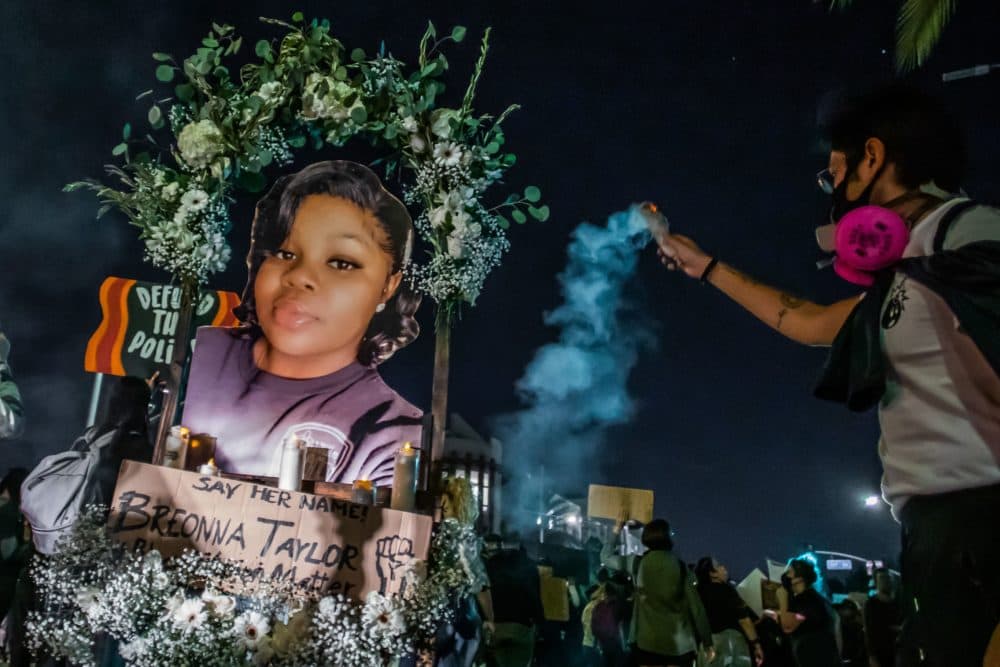Advertisement
Grand Jury Decision In Breonna Taylor Case Raises Further Questions About No-Knock Warrants
Resume
Protests continued through the weekend in Louisville, Kentucky, after a grand jury last week issued no charges against two police officers who shot into Breanna Taylor’s apartment last March, killing her.
Officers used a no-knock warrant to try to find drug crime evidence against Taylor’s ex-boyfriend, who didn't live there. Body camera footage that became public over the weekend shows one of the officers inside the house when police investigators were starting to piece together what happened, which is a violation of protocol.
Taylor’s death has sparked widespread concerns about no-knock warrants.
Last week, Kentucky Attorney General Daniel Cameron said the police who were serving the no-knock warrant did knock and identify themselves. But Taylor’s boyfriend has said he did not hear an announcement and believed it was a home invasion, and only one of 11 neighbors interviewed reported hearing officers announce themselves.
The law generally requires officers to knock, announce themselves and wait a period of time before executing search warrants. This is known as the knock-and-announce rule.
Why Police Use No-Knock Warrants
The purpose of no-knock warrants is to prevent people from destroying evidence by catching them off guard, says Lenese Herbert, Howard University law professor and former assistant U.S. attorney in Washington, D.C.
Typically used in drug cases to protect people or property from harm, these warrants also don’t require an announcement, she says. In Taylor’s case, the officers knocked so loudly that neighbors could hear the commotion, Herbert says.
“They knocked but did not announce,” she says. “And the lack of the announcement, 'We are the police. We are executing a warrant,' that probably caused the most confusion on the other side of that door.”
Coupling the lack of announcement with the use of a battering ram, the people inside the apartment “were probably very frightened, terrified, awakened from sleep” when the officers executed the warrant after midnight, Herbert says.
No-knock warrants set people inside the residence up to feel like they’re under attack because they don’t know it’s the police entering, she says, which is why they’re in dispute.
Concern for the safety of law enforcement executing search warrants is one of the reasons the Supreme Court upheld no-knock warrants, she says. But no-knock warrants are “problematic” in both their foundation and execution, she says, because officers often don’t follow the requirements set by the Supreme Court.
Officers are often confused about how to execute no-knock warrants, she says. With regular warrants, the court has said police are supposed to wait between 15 to 20 seconds before they attempt to enter the premises.
“The no-knock, no one announce is all about surprise,” she says. “If it's all about surprise, if it's to catch those inside off guard, then certainly that seems like police officers’ lives are put in jeopardy by the mere execution of a warrant that otherwise is lawful.”
A Grand Jury Could ‘Indict A Ham Sandwich’
In Taylor’s case, one officer was indicted on three counts of wanton endangerment for shooting into another apartment. Lawyers for Taylor's family say it wasn't the grand jury who made this decision not to charge the officers, but the state attorney general. They want the grand jury transcript to be released.
As an assistant U.S. attorney, Herbert put cases before a grand jury. She says the old saying is generally true: A grand jury would “indict a ham sandwich” if that’s what the prosecutor wanted.
In grand jury trials, prosecutors are the only ones there to present evidence and ask questions, she says.
“Prosecutors in that position almost always get an indictment,” she says. “For some reason, though, in the United States, it seems that this doesn't occur when prosecutors are prosecuting law enforcement officers.”
A number of individuals were already in police custody based on the execution of the warrant, possibly including Taylor’s ex-boyfriend, who was the target of the police investigation, Herbert says.
In drug cases, the ability to obtain a no-knock warrant to acquire evidence depends on whether law enforcement demonstrated probable cause to the magistrate or judge who issued the warrant, she says. Officers can say they expect that people on the premises will have guns and fight back, she says.
Cities And States Move To Ban No-Knock Warrants
In June, the Louisville Metro Council passed Breonna’s Law, banning no-knock warrants and setting guidelines on how search warrants are executed. Most states now allow no-knock warrants after approval from a judge or a magistrate.
But Florida and Oregon have statewide bans. In Virginia, the House of Delegates passed a blanket prohibition. Pennsylvania has introduced Breonna's Law, which would require law enforcement officers to knock and announce themselves when serving a warrant.
Technically, in Taylor’s case, there wasn’t a no-knock warrant because the officers did knock, Herbert says. Police, states and jurisdictions within states are inconsistent in the execution of no-knock warrants, she says.
“No knock warrants are still constitutionally legitimate,” she says, “but we have seen so many problems in the execution and the inconsistency of the execution that we literally are all over the map when it comes to no knock warrants' legitimacy and the execution consistency.”
The court is concerned for the safety of law enforcement during the execution of warrants — but situations such as Taylor’s show no-knock warrants aren’t safe for anyone, Herbert says.
“What we're seeing is that these are dangerous,” she says. “Even if they're done properly, even if they're done well, they present a level of danger on both sides of the equation that seems to be too great and growing too great to ignore.”
Lynn Menegon produced this interview and edited it for broadcast with Tinku Ray. Allison Hagan adapted it for the web.
This segment aired on September 28, 2020.

